Patterns, Pretensions, and the Guanajuato Mint
by R. G. Doty
In 1969, Ted Buttrey published the first edition of his Guide book of Mexican Coins. In it, he described two copper pattern quarter-reales, or cuartillas, one dated 1828 and the other 1836. He noted many similarities between the two pieces, relating them both to the Guanajuato mint. He was right, but for the wrong reasons.
The two coins formed part of a much larger picture, one occupying the second quarter of the nineteenth century, one whose roots were deeper still, one whose results were seen in Mexico – but whose origins lay in the British Midlands. Both patterns originated in the workshops of the Soho Mint, and how and why they came to be is a fascinating story of idealism and opportunity, misapprehension and greed.
Our story begins in the wake of Mexico’s War for Independence. That conflict had left the country free but bankrupt, exhausted, its infrastructure in shambles. Outside capital was needed if the new nation was to realize the dreams of those who had fought to create it. Mining was of particular importance. New Spain had been known for its wealth in precious metals, especially silver; but the country’s mining industry would require massive amounts of capital and work before production could fully resume, let alone expand.
Just as Mexico and other Latin American countries were seeking outside capital, outside capital, especially British, was seeking new fields for investment. The Spanish El Dorado had been on British radar for centuries; now, at last, Spain had departed, apparently leaving the door to wealth wide open. Britons, and their technical expertise, and especially their money, now clamored to come in.
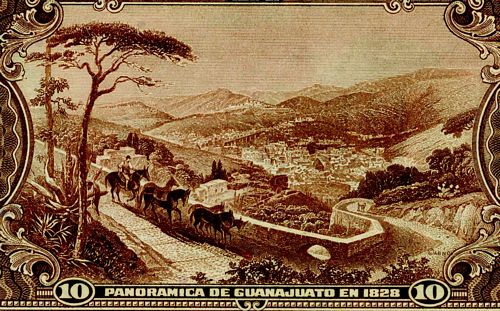
As I said, the refurbishing and development of Mexican silver mines attracted great attention, especially those around the north-central town of Guanajuato. The area’s precious metal had long been carried by mule back to Mexico City for coining. The War for Independence made such commerce risky at best and led to the establishment of an emergency branch mint at Guanajuato. This mint remained in business after independence was achieved in 1821, and by the mid-1820s, plans were afoot to refurbish both it and the mines it served. And this is where our story really begins.
All of the main actors in our tale were British. One was the venerable firm called Boulton, Watt & Company, which had been making coining machinery (and a good many other things) for decades. It was located in Soho, a suburb of Birmingham, and was captained by Matthew Robinson Boulton and James Watt, Jr. The other players were two closely-allied London firms, the Anglo Mexican Mining Association and the Anglo Mexican Mint Association. The Mining Association had become deeply involved in the resurrection of Guanajuato’s mines by 1825, and the search for a market for the silver it now hoped to tear from the earth brought the Mint Association into play as well. The silver appeared to be there for the taking, but unless the Guanajuato mint was modernized, provided with cutting-edge machinery on the Boulton, Watt model, it could never hope to process enough silver to make the operation profitable. So the London firms went to work, in two steps. First, they entered into a ten-year contract with the State of Guanajuato, by which they would replace the ramshackle mint with a splendid new one, pay the salaries of all the employees, and, best of all, hand the whole thing over to the local authorities at contract’s end – at no charge.
The Britons were no fools, and they based their generosity on two assumptions. First, the mines were immensely rich. Second, improved, steam-powered machinery would enable them to take so much silver out of the ground (and turn it into so many millions of coins) that it would be impossible not to grow rich from the scheme. If you assumed that there would be a one-time cost of ten thousand pounds to upgrade the mint, the refurbished, more productive facility could make that investment back during its first year, and twenty-six thousand pounds profit besides. And then it would be pure profit for the next nine years. The London group had discovered an enduring law of manufacturing: if you make and distribute enough of anything, it doesn’t particularly matter what you charge for any single unit; volume will take care of you.
Once the contract had been signed, the second step was taken. Boulton, Watt & Company was asked to manufacture the steam engines, rolling mill, coining presses, and the other accoutrements of a thoroughly modern mint. A contract was signed to the tune of nearly nine thousand pounds: work got underway.
And then reality intervened.
To operate a steam-powered mint, you needed three things. You needed water. You needed fuel. And you obviously needed metal to coin. By the summer of 1826, it was becoming apparent that all of these requirements were in somewhat short supply. A senior executive in London had learned that fuel might be scarce, although he neglected to tell anyone about it. Then an employee on the scene in Guanajuato sent back reports that running water was a problem – non-existent during several months of the year. Worst of all, there didn’t seem to be much silver in the region either. Not for the first time, and certainly not for the last, European optimism and greed went eyeball to eyeball with American reality, and blinked first.
There ensued an emotional and financial meltdown. Members of the Mining and Mint Associations turned on each other, then found solutions of sorts. They would ask James Watt, Jr. to take back the two steam engines he had built for them – which he did, and apparently had little trouble selling them to someone else. They would ask Matthew Robinson Boulton to sell the unwanted minting machinery on their behalf – which Boulton attempted to do, with little success, for the next decade and a half. Finally, they’d place an order for a much-reduced, pre-industrial mint for Guanajuato, one more in line with reality. The new, smaller facility was prepared, shipped, and was going into operation by the beginning of the 1830s. And it, at least, proved a success.
I have written several articles and part of a book on the trials and tribulations of the Guanajuato mint; those interested should consult my Soho Mint and the Industrialization of Money (1998) and ’A Mint for Mexico’: Boulton, Watt and the Guanajuato Mint (1986). Here, I wish to focus on one area – the production of dies for coinage. As you’ll see, it has a direct relationship with the two pattern cuartillas with which we began.
By law, all dies for Mexican coinage had to be prepared at the central mint in Mexico City and shipped to the various branches. This involved great risk and inconvenience. What if crooks intercepted a die shipment? What if crucial dies weren’t available at the time and place where they were needed? These considerations led the British coiners at Guanajuato to a crucial decision, and an illegal request: could Boulton, Watt & Company make dies for a Mexican coinage and then send them to Guanajuato? The firm could – and did, for well over a decade. But the dies were officially contraband, and much agonizing ensued on both sides of the Atlantic over how best to send dies from Point A to Point B, especially when they risked scrutiny by eagle-eyed customs inspectors at point C – the port of Veracruz, through which virtually all European imports passed. The situation wasn’t helped by demands that the British dies be identical with Mexican ones in all respects, and yet somehow superior to them as well – remnants of the desire for industrial excellence that had helped tempt the Londoners into the minting business in the first place. Matthew Robinson Boulton and those who worked for him at the Soho Mint racked their brains, did their best – and came up with various attempts to square the circle. Their products were handsome – and there’s just enough variation so that we can discern between them and the objects they were intended to represent, and to replace.
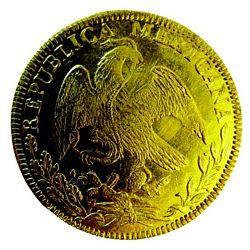
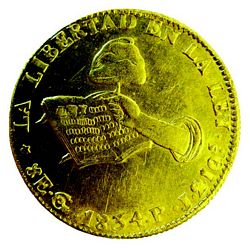
1834 8 Escudos Mexican Dies
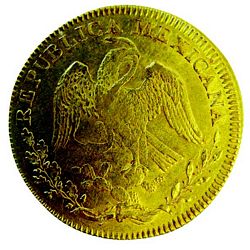
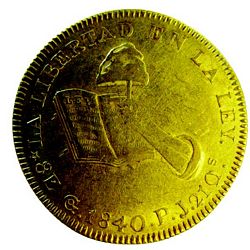
1840 8 Escudos British Dies
The greatest attention was paid to, and the least variation allowed in, dies for the peso, or eight-real silver coin. There was good reason for this concern: this denomination was the workhorse of the Mexican economic system, and any major departures from the norm would be quickly spotted. So an 1832 peso struck from British dies retains most of the characteristics of an 1830 coin, struck from Mexican ones, the only major difference being the more prominent beaded borders on the 1830 coin. Somewhat greater variation was allowed for dies intended for gold coins and for minor silver ones, perhaps in the belief that these denominations would encounter less scrutiny. For minor silver, the gorro frigio (Phrygian cap) on the reverse acquires an almost triangular configuration; but the most obvious difference between these minor silver coins and their earlier counterparts is the obverse eagle. As with the gold, the bird is no longer a caricature but a realistic image, the product of a gifted Soho artist named John Sherriff.
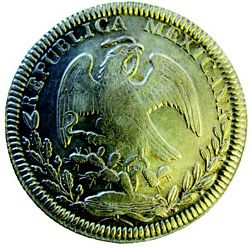
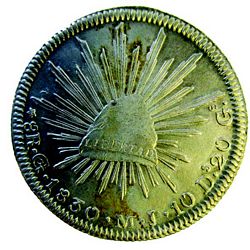
1830 8 Reales Mexican Dies
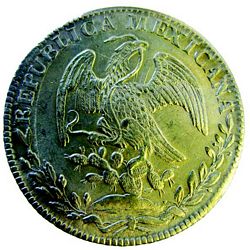
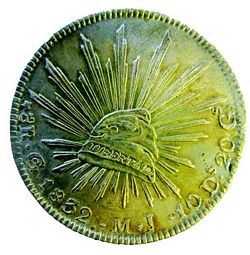
1832 8 Reales British Dies
These coins are hybrids, created by a Mexican mint from British dies. But from this point of departure, attention and speculation rather naturally turned in a new direction. Instead of striking coins from British dies in Mexico, why not strike them from British dies in Britain? Here is where the two pattern cuartillas enter our story, and that of Mexican numismatics.
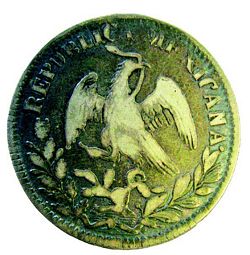
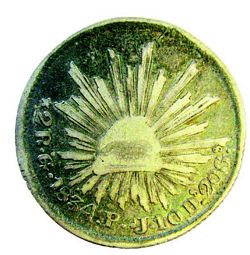
1834 2 Reales Mexican Dies
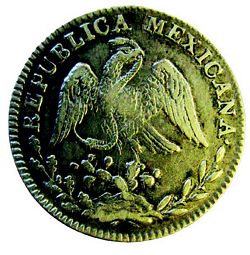
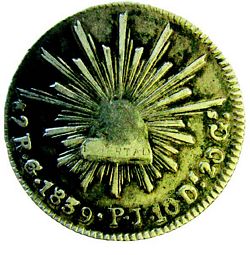
1839 2 Reales British Dies
Mexican coinage followed rules laid down in the country’s basic law, the Constitution of 1824. That document proclaimed a federal republic, with much sovereignty reserved to the constituent states. Since the making of coinage has always been recognized as a mark of identity and power, Mexico would have two types of coinage rather than one. The central government (through the Mexico City mint and its branches) would take care of the country’s needs for a national coinage of silver and gold, whose designs would adhere to tenets laid down in a decree of 1 August 1823 (among other things, this decree stipulated that the eagle and serpent would graces the obverses of Mexican coins, and they still do). But the federal government left most base-metal coinage up to the states. They could choose their own designs, their own metals, and to a degree their own denominations. Between the mid-1820s and the early 1870s, no fewer than eight states struck their own coins, denominated at a quarter, an eighth, and in one case a sixteenth of a real: Chihuahua, Durango, Jalisco, Occidente/Sinaloa, San Luis Potosí, Sonora, Zacatecas – and Guanajuato.
In Guanajuato as elsewhere, the reach of the local coiners exceeded their grasp. Had they been well-struck, the state’s products would have been impressive, with a seated figure emblematic of Guanajuato on the obverse, a Liberty cap in a circle of radiant light on the reverse. But they were not well-struck, and matters were made worse by a cheerful lack of quality control over the metal from which they were made. The composition of Guanajuato’s cuartillas and octavos (eighths) varied from something approaching pure copper to something resembling brass: all in all, this coinage offered a tempting target for local forgers.
A senior executive with the Anglo Mexican Mint Association named George B. Lonsdale believed the designs deserved better treatment. Late in 1831, he asked Boulton, Watt & Company for help. Could the firm replicate the designs on a new state coinage, struck in collar by steam and exported to Mexico? Matthew Robinson Boulton was interested: at the time, his Soho Mint was running at half-speed, its activities limited to creating the latest bunch of planchets for United States copper coinage and striking tokens for Singapore. Neither project was overwhelming, so Boulton instructed his designers to create a perfect version of the imperfect Guanajuato model.
By the turn of the year, Lonsdale and his associates were having second thoughts. They worried that the new coins would invite detection because they would be too perfect. Their fears were justified, as a comparison between a Guanajuato original and a Boulton pattern suggests. The patterns (struck in January 1832 but dated 1828, inviting comparison with the originals) were simply head and shoulders above the Guanajuato strikes, ranking among the most beautiful products that the Soho Mint ever struck. But would they ever see circulation in Mexico? As it happened, they would not.
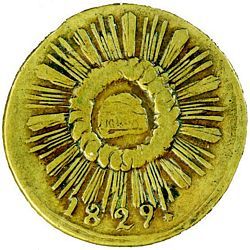
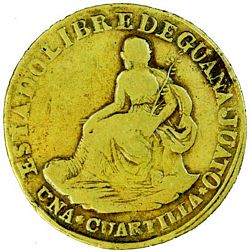
1829 Cuartilla Mexican Dies
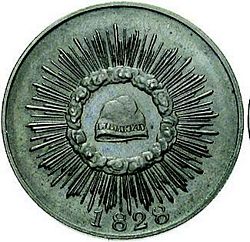
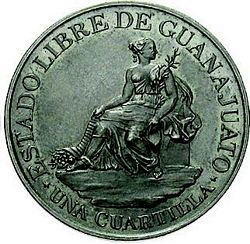
1828 Cuartilla Pattern British Dies
Fretting over the possible risks in carrying the project forward, Lonsdale attempted to shift responsibility for it onto another’s shoulders. The Mexican minister in London was duly approached for his blessings – but he neatly shifted responsibility back to Lonsdale, explaining that, as he represented the entire nation rather than a single state, he lacked the authority to render an opinion. Still dithering but hoping for the best, Lonsdale instructed Boulton, Watt & Company to go on with the project; accordingly, the firm struck a couple of specimens and sent them to the Mint Association’s London office. The specimens were approved, and Lonsdale asked that another dozen or so trials be quickly struck off and sent to London for shipment on the next packet bound for Veracruz. His request for celerity was apparently founded on the realization that the entire venture was deeply speculative, and that it would therefore be wise to present the people in Guanajuato with a fait accompli as quickly as possible. Boulton, Watt & Company were unable to comply (speed was never one of the firm’s strong points). Lonsdale indeed received his patterns, but not in time for the packet. So the opportunity was missed, and these magnificent patterns are all that remain from one of Mexican numismatics’ greatest mights-have-been.
The cuartilla pattern dated 1828 is related to another, dated 1836. This is the other piece that Dr. Buttrey tentatively ascribed to Guanajuato – and it’s easy to see why. Except for the date, the reverses of the two patterns are essentially identical. But the second piece was created for a different, and altogether more ambitious, purpose.
While the individual states enjoyed the right to coin copper money, so did the federal government. The central mint at Mexico City began doing so in 1829 – planning to strike base-metal pieces worth a quarter, an eighth, and a sixteenth of a real. Production of federal cuartillas got under way that spring, but the new coins were so heavy that they tended to break the antiquated presses, and it cost nearly as much to make them as they were worth. Even with a reduction in size that summer, the cuartillas (and their smaller brethren, whose production got under way the following year) proved a major disappointment for the central mint and a major annoyance for the people who were forced to use them. The coins were poorly struck and were almost immediately counterfeited on a massive scale. So great did the problem with false federal – and state – coinages become that the national government finally suspended all base-metal issues, including its own, on 17 January 1837. And it is at this point that the pattern cuartilla dated 1836 enters the picture.
Struck in collar, the pattern is unquestionably a product of the Soho Mint. I’ve noted the similarity between its reverse and that of the Guanajuato trial. Now look at the obverse: we’ve seen that eagle before, on dies prepared for Guanajuato. This piece came about in the following way.
By the mid-1830s, opposition to the crude federal copper coinage had reached serious proportions. Someone at the Guanajuato mint must have written home to Lonsdale mentioning the situation. By a letter of 16 December 1835, Lonsdale passed the information on to Matthew Robinson Boulton, advising him that another opportunity to create a copper coinage for Mexico had just opened up.
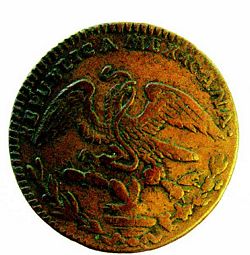
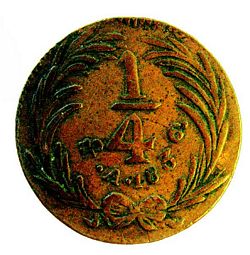
Mexican Republic 1836 Quarter Real
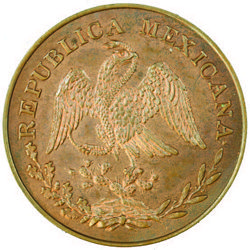
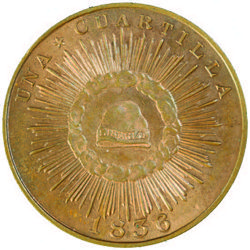
Soho Mint 1836 Pattern Quarter Real
The copper cuartilla pattern of 1836 was the result. Work on it began around Christmas 1835. The designer, almost certainly John Sherriff once again, changed the date on the reverse die to match that of the upcoming year, combined it with one of his eagles – and Lonsdale was sent three dozen of the new patterns on 12 January 1836.
They fared no better than the earlier ones for Guanajuato. But both sets of coins bear witness to a fascinating and distant time, when the world seemed new and anything seemed possible. They are, in fact, witnesses to an alternate reality.
